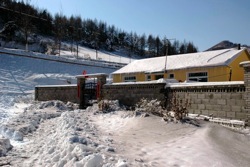
Huangbaiyu The Project
The Business of Leaders and Commoners
On September 1, 2006 Zhao Qinghao and Yi Shiqin became the first residents of the Huangbaiyu China-US Sustainable Development Model Village. What had begun four years earlier as a shared vision between a consortium of Chinese government leaders and US corporate representatives to live up to their mission to “leapfrog past limitations and accelerate sustainable development” by building China’s first rural sustainable community was now built in a narrow valley pass in the mountains of eastern Liaoning province.
Where maize was once grown, forty-two houses are now the first harvest of the green design expert William McDonough’s plans for a “sustainable rural village that the government hopes will serve as a prototype for improving the lives of 800 million rural Chinese”. Environmentalists and journalists across the globe have heralded the Huangbaiyu eco-city project as critical in the fight against global warming, with leading Chinese environmental commentator, Elizabeth Economy calling the project “perhaps the most ambitious multinational effort to help redirect China on to a new development path.”
Five days after Zhao and Yi’s move into the new development, a caravan of black Audi sedans drove past the 35-ton rock announcing the entrance to Huangbaiyu’s Model Village. As they entered the development, they passed by a brass plaque naming it as a regional nominee to China’s 100 Model Villages Project, and then parked in a line on the dirt boulevard leading to Zhao and Yi’s new house. Provincial Party officials, scientists and journalists on an official study tour emerged from their cars, and were taken on a tour of, according to the developer, Dai Xiaolong, the “World’s First Village,” a place where global climate and energy problems would find solutions in the “cradle-to-cradle”, “sustainable development”, and “ecological” concepts manifested in the master plan being built here.
Zhao is flabbergasted each time government officials and visiting dignitaries arrive to inspect his house, and more than a bit confused by why they are all there. Afflicted with polio and married to a women openly addressed by neighbors as an idiot, Zhao and Yi are not used to positive attention from others, let alone people whose great political and social worth is displayed in their cars, clothes, and cameras, and their unabashed tendencies to simply walk into his home without acknowledging him.
He silently smiles as he limps out of the way of official after official who never converse with him during their tours of his home in the model village, and leave his wife to mop up their muddy footprints. He tries to understand what is so important by listening to the words used over and over by all the strangers who come to see how he lives. But there are so many words with which he is unfamiliar.
“Ecology” is a term that has suddenly entered the language spoken around him, but the meaning of which remains elusive. Like the strong majority of women and most men I interviewed living in the valleys of Huangbaiyu’s “non-model” villages, Zhao and Yi stumbled at the term.
When Dai and other visitors spoke of “ecology” while walking through their house, Zhao and Yi wondered why anyone was interested in their or anyone else’s feelings about family planning policies. Talk about the “cradle-to-cradle principle” of American designer William McDonough just reinforced Zhao and Yi’s thoughts that whenever Dai or other visitors hailed the coming of an “ecological age” that some new family planning policy was upon them, and somehow these houses were part of it. Standing with his post-menopausal wife, this always caused Zhao to chortle.
Zhao does not laugh, however, when I tell him this house and the master plan of which it is a part may serve as a model for how to improve the lives of 800 million other rural Chinese, as McDonough had announced. Shivering with Zhao and his wife a month after they moved into their new house in the Huangbaiyu model village—a month after the government officials had taken their photographs and left—I asked Zhao what he thought of sustainable development.
Although he had heard “sustainable development” lauded by their national leaders on the nightly national news, what exactly that might have to do with the house he was just moved into was beyond his imagination. He thought that sustainable development would obviously mean that at long last some development would come his way that would sustain his life—by providing him with a steady, reliable income to spend. “Sustainable development is my development. Then we’ll be sustained instead of barely subsisting. That is what we [farmers] are waiting for,” he said.
This house in this “sustainable development model village”, on the contrary, had brought greater insecurity into his future. In the “sustainable dream town” lauded as a key to a global “future that is both bright and green,” there was no room for his goatherd, or place to cure his maize. He was also now isolated from both his kin and neighbors with whom he had long-term reciprocal relationships in Zhao Family Village, the area of Huangbaiyu in which he had lived. Hearing that international experts and news media have heralded this model of development as a one of the keys to stemming global climate change, he stares at me, dumbfounded. Zhao considers my statement while studiously rolling tobacco in his hands. “The business of leaders and commoners is different.”
Interested in more moments from Huangbaiyu? Read about The Opening Ceremonies or Chinese-American Sustainable Development Dumplings.


Copyright © 2008-2009 Shannon May About me Design Blog Kenya & Life Sundries Blog Contact smay at post dot harvard dot edu
Everything is a work in progress